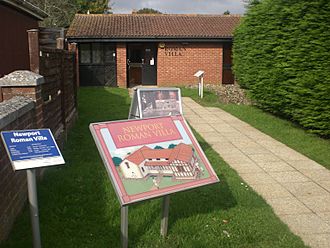Newport Roman Villa facts for kids
Quick facts for kids Newport Roman Villa |
|
|---|---|

Museum entrance
|
|
| General information | |
| Location | Isle of Wight, England, UK |
| Coordinates | 50°41′40″N 1°17′30″W / 50.6945°N 1.2918°W |
| OS grid | SZ500885 |
The Newport Roman Villa is an ancient Roman building. It was built around 280 AD. This villa was likely a large, fancy farmhouse. It is located close to Newport, Isle of Wight, on the beautiful Isle of Wight in England. Today, you can visit it as a museum!
Contents
Discovering the Ancient Villa
How the Villa Was Found
The Newport Roman Villa was discovered by accident in 1926. A homeowner was digging foundations for a garage. Suddenly, they found old Roman remains! This led to archaeologists carefully digging up the site. They uncovered the full layout of the villa.
Saving the Villa for Everyone
After the discovery, a kind man named Alderman John Curtis Millgate wanted to protect the villa. He was the Mayor of Newport at the time. He suggested that the Newport Town Council take over the site. He even wanted a building put over it to keep it safe.
However, the council thought it would cost too much money. So, Alderman Millgate decided to buy the land himself! He built a special cover over the villa to protect it.
When he passed away in 1956, his daughter, Grace Millgate, took care of the site. In 1960, the protective building needed repairs. Miss Millgate offered the villa to the Newport Town Council again. But they still said no because of the cost.
Finally, the Isle of Wight Council stepped in. In December 1960, they agreed to accept the villa as a gift from Miss Millgate. The official handover happened in April 1961. Today, the Newport Roman Villa is a scheduled ancient monument. This means it has special protection to keep it safe for the future.
Life at the Roman Villa
Building a Roman Home
The Newport Roman Villa was built around 280 AD. The builders used local stones like flint, chalk, and limestone. The walls are still almost as tall as they were back then! The roof was made of heavy limestone slabs. This meant the roof needed very strong wooden beams to hold it up. Many roof pieces found had a single hole for a nail.
This villa was probably the center of a very rich estate. It was a grand home for an important Roman family.
Inside the Villa: Colors and Warmth
Archaeologists found pieces of window glass at the site. This shows that some windows in the villa had glass, which was quite fancy for the time! They also found bits of painted wall plaster. This tells us that some rooms had bright, colorful walls. Imagine how vibrant it must have looked!
One of the most exciting features is the well-preserved Roman bath suite. The Romans loved their baths! This villa had a special hypocaust system. This was a clever way to heat the floors from underneath. A slave would feed a furnace outside the bath wing. Hot air from the furnace would then flow under the raised floors of three rooms. This kept the bath area warm and cozy.
The End of the Villa's Story
We don't know exactly when people stopped living at the Newport Roman Villa. During the digs, archaeologists found the skull of a woman. She was in her early thirties and found in a corner of one room. Some people think she might have been killed during a raid.
However, it's also thought that many Roman villas on the island were left empty by the mid-fourth century. This might have been due to money problems. It could also have been because of threats from Anglo-saxon raiders.
Visiting the Villa Today
A Museum for All Ages
The Newport Roman Villa has been rebuilt based on what archaeologists found. It now includes a Roman kitchen and a Roman garden. It's open to the public, usually from April to October each year.
Many people visit the villa, with over 5,000 visitors every year. Plus, about 1,400 school children come for educational trips! The villa is located on Cypress Road in Newport, Isle of Wight, right in the middle of a neighborhood.
Protecting the Past for the Future
In 2009, the villa underwent a big project. The roof of the cover-building was replaced. This was important to protect the ancient remains from weather damage. The Isle of Wight Council and English Heritage helped pay for this project. English Heritage gave over £40,000!
The new roof was designed to improve the conditions inside. It helps reduce moisture, which had caused algae to grow on the beautiful Roman mosaics below. This ensures the villa stays safe and preserved for many more years.

